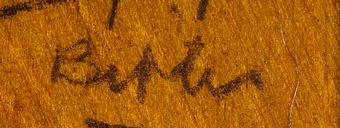
Identified individuals are represented by a biographical sketch, a list of connections to other signatures, and, in most cases, an artifact from the Ransom Centers collections. Help us identify more signatures by submitting your suggested identification.
X
X
X
X
 Location on door: front, panel 3
Location on door: front, panel 3
PAUL THOMPSON
The work of documentary photographer Paul Thompson (dates unknown) appeared regularly throughout the 1910s and 1920s in newspapers, popular magazines, and art magazines. He ran a photography agency in the 1910s, employing other photographers and providing journalists, magazines, and newspapers with images from his photo archive. He travelled to Europe to document the First World War, and his images appear on American propaganda posters of the period.

- View larger image
- View metadata
X
Creator: Thompson, Paul
Title: "This is not a Nevison: Negro Troopers marching up Fifth Avenue on the last lap of their journey from Paris to Harlem" in Playboy
Imprint: No. 2 (1919)
Item Date: 1919
Material Type: Serials
ADA Caption: "This is not a Nevison: Negro Troopers marching up Fifth Avenue on the last lap of their journey from Paris to Harlem" in Playboy
Curatorial Department: Book Collection
Collection Name: Rare Books Collection
Stack Location: q N 1 P5 no. 2 (1919)
Copyright Notices: Some of the documents shown here are subject to U. S. copyright law. It is the user's sole responsibility to contact the copyright holder and secure any necessary copyright permission to publish documents, texts, and images from any holders of rights in these materials. As the owner of the physical object (not the underlying copyright), the Ransom Center requires that you also contact us if you wish to reproduce an image shown here in a print publication or electronically.
Every effort has been made to trace copyright ownership and to obtain permission for reproduction. If you believe you are the copyright owner of an item on this site, and we have not requested your permission, please contact us.
X
Paul Thompson's "This is not a Nevinson: Negro Troopers marching up Fifth Avenue on the last lap of their journey from Paris to Harlem" in Playboy: A Portfolio of Art and Satire 2 (1919)
This image, printed in Egmont Arens's art periodical Playboy, marks an important event of the First World War and of African-American history. The 369th Regiment--known as "The Hellfighters of Harlem"--was one of the most highly decorated American regiments, and served the most days in combat of any American unit. They gained fame at home through newspaper reports of their actions and fame in France through their renowned band, which supposedly helped set off the jazz craze in Europe. When they left for the war as a National Guard unit, they had not been allowed to march with other Guardsmen through New York because they were Black. Their white commander, Colonel William Haywood, ensured that this would not happen upon their return. Arriving in February 1919, they were met by a crowd estimated at one million people, who cheered them as they marched up Fifth Avenue from Madison Square to Harlem. The title of the photograph takes a jab at the English artist C. R. W. Nevinson, the futurist turned war artist who visited New York in 1919 on a wave of celebrity, only to alienate himself by making condescending public statements about the state of American art.

















































